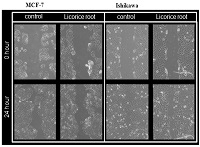Estrogenic and anti-proliferative activity of water extract of Glycyrhizzic uralensis (licorice root)
Keywords:
Glycyrrhizic acid, Glycyrrhiza uralensis, Health functional food, Licorice root, PhytoestrogenAbstract
Licorice is the root of Glycyrrhiza uralensis, which is a commonly used herb in traditional Chinese medicine. Licorice extract has been claimed to have anti-cancer, anti-viral, anti-inflammatory and anti-diabetic activities. This study evaluated the estrogenic effect of licorice root water extract on Ishikawa cells and related it to its effect on cell proliferation using various cell lines in comparison to glycyrrhizic acid (GA). This study showed that licorice root extract exhibited estrogenic property while decreasing cell proliferation thus suggesting possible use in estrogen replacement agent with anti-proliferative property. Even though GA is the most studied active component in licorice, these two properties were not seen in the cell lines tested; hence suggesting that GA is not responsible for these activities. These results showed that licorice could be further studied as an estrogen replacement agent as it does not cause an increase in cell proliferation in the breast and uterus.
References
. Cherng JM, Lin HJ, Hung MS, Lin YR, Chan MH, Lin JC: Inhibition of nuclear factor kappaB is associated with neuroprotective effects of glycyrrhizic acid on glutamate-induced excitotoxicity in primary neurons. Eur J Pharmacol, 2006;547:10-21.
. Suzuki F, Schmitt DA, Utsunomiya T, Pollard RB: Stimulation of host resistance against tumors by glycyrrhizin, an active component of licorice roots. In Vivo, 1992;6:589-96.
. Fiore C, Eisenhut M, Krausse R, Ragazzi E, Pellati D, Armanini D, Bielenberg J: Antiviral effects of Glycyrrhiza species. Phytother Res, 2008;22:141-8.
. Fujisawa Y, Sakamoto M, Matsushita M, Fujita T, Nishioka K: Glycyrrhizin inhibits the lytic pathway of complement--possible mechanism of its anti-inflammatory effect on liver cells in viral hepatitis. Microbiol Immunol, 2000;44:799-804.
. Zava DT, Blen M, Duwe G: Estrogenic activity of natural and synthetic estrogens in human breast cancer cells in culture. Environ Health Perspect, 1997;105:637-45.
. Simons R, Vincken JP, Mol LA, The SA, Bovee TF, Luijendijk TJ, Verbruggen MA, Gruppen H: Agonistic and antagonistic estrogens in licorice root (Glycyrrhiza glabra). Anal Bioanal Chem, 2011;401:305-13.
. Hu C, Liu H, Du J, Mo B, Qi H, Wang X, Ye S, Li Z: Estrogenic activities of extracts of Chinese licorice (Glycyrrhiza uralensis) root in MCF-7 breast cancer cells. J Steroid Biochem Mol Biol, 2009;113:209-16.
. Rauchensteiner F, Matsumura Y, Yamamoto Y, Yamaji S, Tani T: Analysis and comparison of Radix Glycyrrhizae (licorice) from Europe and China by capillary-zone electrophoresis (CZE). J Pharm Biomed Anal, 2005;38:594-600.
. Tian M, Yan H, Row KH: Extraction of glycyrrhizic acid and glabridin from licorice. Int J Mol Sci, 2008;9:571-7.
. Mense SM, Hei TK, Ganju RK, Bhat HK: Phytoestrogens and breast cancer prevention: possible mechanisms of action. Environ Health Perspect , 2008;116:426-33.
. Kalita J, Milligan S: In vitro estrogenic potency of phytoestrogen-glycosides and some plant flavanoids. Indian J Sci Technol, 2010;3:1142-1147.
. Kuiper GG, Carlsson B, Grandien K, Enmark E, Haggblad J, Nilsson S, Gustafsson JA: Comparison of the ligand binding specificity and transcript tissue distribution of estrogen receptors alpha and beta. Endocrinol, 1997;138: 863-70.
. Moutsatsou P: The spectrum of phytoestrogens in nature: our knowledge is expanding. Hormones (Athens), 2007;6:173-93.
. Schmitt E, Dekant W, Stopper H: Assaying the estrogenicity of phytoestrogens in cells of different estrogen sensitive tissues. Toxicol In Vitro, 2001;15:433-9.
. Rice S, Whitehead SA: Phytoestrogens and breast cancer--promoters or protectors? Endocr-Relat Cancer, 2006;13:995-1015.
. Ososki AL, Kennelly EJ: Phytoestrogens: a review of the present state of research. Phyto Res, 2003;17:845-69.
. Littlefield, B. A.; Gurpide, E.; Markiewicz, L.; McKinley, B.; Hochberg, R. B., A simple and sensitive microtiter plate estrogen bioassay based on stimulation of alkaline phosphatase in Ishikawa cells: estrogenic action of delta 5 adrenal steroids. Endocrinol, 1990,127:2757-62.
. Jo YH, Choi YJ, Kim HO, Yoon KS, Lee BY, Jung MH, Huh CY: Corticotropin-releasing hormone enhances the invasiveness and migration of Ishikawa cells, possibly by increasing matrix metalloproteinase-2 and matrix metalloproteinase-9. J Int Med Res, 2011;39:2067-75.
. Poh SWM, Visweswaran V, and Chia YY: Estrogenic assessment of Labisia pumila extracts using a human endometrial cell line. Int J Pharm and Pharm Sci, 2013;5: 448-52.
. Rosman DS, Phukan S, Huang CC, Pasche B: TGFBR1*6A enhances the migration and invasion of MCF-7 breast cancer cells through RhoA activation. Cancer Res, 2008;68:1319-28.
. Holinka CF, Hata H, Kuramoto H, Gurpide E: Effects of steroid hormones and antisteroids on alkaline phosphatase activity in human endometrial cancer cells (Ishikawa line). Cancer Res, 1986;46:2771-4.
. Bhat KP and Pezzuto JM: Resveratrol exhibits cytostatic and antiestrogenic properties with human endometrial adenocarcinoma (Ishikawa) cells. Cancer Res, 2001;61:6137-44.
. Kayisli UA, Aksu CA, Berkkanoglu M, Arici A: Estrogenicity of isoflavones on human endometrial stromal and glandular cells. J Clin Endocrinol and Metabol, 2002;87:5539-44.
. Berthois Y, Katzenellenbogen JA, Katzenellenbogen BS: Phenol red in tissue culture media is a weak estrogen: implications concerning the study of estrogen-responsive cells in culture. Proc Natl Acad Sci USA, 1986;83:2496-500.
. Nishida M: The Ishikawa cells from birth to the present. Hum Cell, 2002;15:104-17.
. Brooks SC, Locke ER, Soule HD: Estrogen receptor in a human cell line (MCF-7) from breast carcinoma. J Biol Chem, 1973;248:6251-3.
. Cos P, De Bruyne T, Apers S, Vanden Berghe D, Pieters L, Vlietinck AJ: Phytoestrogens: recent developments. Planta Med, 2003;69:589-99.
. Liu J, Burdette JE, Xu H, Gu C, van Breemen RB, Bhat KP, Booth N, Constantinou AI, Pezzuto JM, Fong HH, Farnsworth NR, Bolton JL: Evaluation of estrogenic activity of plant extracts for the potential treatment of menopausal symptoms. J Agric Food Chem, 2001;49:2472-9.
. Tamir S, Eizenberg M, Somjen D, Stern N, Shelach R, Kaye A, Vaya J: Estrogenic and antiproliferative properties of glabridin from licorice in human breast cancer cells. Cancer Res, 2000;60:5704-9.
. Tamir S, Eizenberg M, Somjen D, Izrael S, Vaya J: Estrogen-like activity of glabrene and other constituents isolated from licorice root. J Steroid Biochem Mol Biol, 2001;78:291-8.



